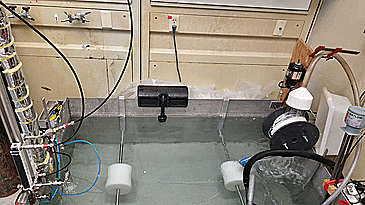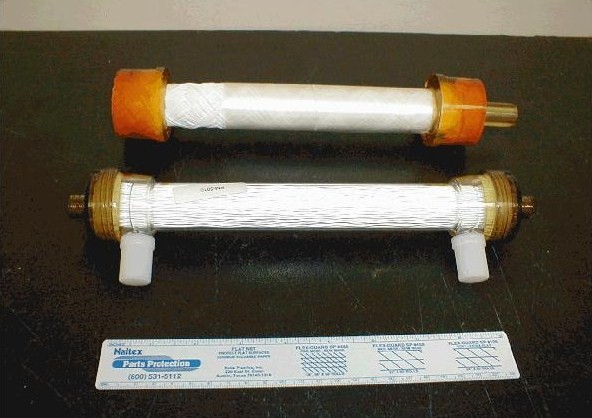Hollow Fiber Membrane on:
[Wikipedia]
[Google]
[Amazon]
Hollow fiber membranes (HFMs) are a class of artificial membranes containing a semi-permeable barrier in the form of a hollow fiber. Originally developed in the 1960s for 



 Hollow fiber membranes are ubiquitously used in industrial separations, especially the filtration of drinking water.
Industrial water filters are mainly equipped with ultrafiltration hollow filer membranes. Domestic water filtration systems have microfiltration hollow fiber membranes. In microfiltration a membrane pore diameter of 0.1 micrometers cuts-off microorganisms like germs and bacteria, Giardia cysts and other intestinal parasites, as well removing sediments. Ultrafiltration membranes are capable of removing not only bacteria, but also viruses.
Hollow fibers are commonly used substrates for specialized bioreactor systems, with the ability of some hollow fiber cartridges to culture billions of anchorage-dependent cells within a relatively low (<100 mL) bioreactor volume.
Hollow fibers can be used for drug efficacy testing in cancer research, as an alternative to the traditional, but more expensive, xenograft model.
Hollow fiber membranes are used in
Hollow fiber membranes are ubiquitously used in industrial separations, especially the filtration of drinking water.
Industrial water filters are mainly equipped with ultrafiltration hollow filer membranes. Domestic water filtration systems have microfiltration hollow fiber membranes. In microfiltration a membrane pore diameter of 0.1 micrometers cuts-off microorganisms like germs and bacteria, Giardia cysts and other intestinal parasites, as well removing sediments. Ultrafiltration membranes are capable of removing not only bacteria, but also viruses.
Hollow fibers are commonly used substrates for specialized bioreactor systems, with the ability of some hollow fiber cartridges to culture billions of anchorage-dependent cells within a relatively low (<100 mL) bioreactor volume.
Hollow fibers can be used for drug efficacy testing in cancer research, as an alternative to the traditional, but more expensive, xenograft model.
Hollow fiber membranes are used in 
reverse osmosis
Reverse osmosis (RO) is a water purification process that uses a partially permeable membrane to separate ions, unwanted molecules and larger particles from drinking water. In reverse osmosis, an applied pressure is used to overcome osmotic pre ...
applications, hollow fiber membranes have since become prevalent in water treatment, desalination, cell culture, medicine, and tissue engineering. Most commercial hollow fiber membranes are packed into cartridges which can be used for a variety of liquid and gaseous separations.




Manufacturing
HFMs are commonly produced using artificial polymers. The specific production methods involved are heavily dependent on the type of polymer used as well as itsmolecular weight
A molecule is a group of two or more atoms held together by attractive forces known as chemical bonds; depending on context, the term may or may not include ions which satisfy this criterion. In quantum physics, organic chemistry, and bioch ...
. HFM production, commonly referred to as "spinning," can be divided into four general types:
* Melt Spinning, in which a thermoplastic polymer is melted and extruded through a spinneret
A spinneret is a silk-spinning organ of a spider or the larva of an insect. Some adult insects also have spinnerets, such as those borne on the forelegs of Embioptera. Spinnerets are usually on the underside of a spider's opisthosoma, and are ...
into air and subsequently cooled.
* Dry Spinning, in which a polymer is dissolved in an appropriate solvent and extruded through a spinneret into air.
* Dry-Jet Wet Spinning, in which a polymer is dissolved in an appropriate solvent and extruded into air and a subsequent coagulant (usually water).
* Wet spinning, in which a polymer is dissolved and extruded directly into a coagulant (usually water).
Common to each of these methods is the use of a spinneret
A spinneret is a silk-spinning organ of a spider or the larva of an insect. Some adult insects also have spinnerets, such as those borne on the forelegs of Embioptera. Spinnerets are usually on the underside of a spider's opisthosoma, and are ...
, a device containing a needle through which solvent is extruded and an annulus through which a polymer solution is extruded. As the polymer is extruded through the annulus of the spinneret, it retains a hollow cylindrical shape. As the polymer exits the spinneret, it solidifies into a membrane through a process known as phase inversion. The properties of the membrane -such as average pore diameter and membrane thickness- can be finely tuned by changing the dimensions of the spinneret, temperature and composition of "dope" (polymer) and "bore" (solvent) solutions, length of air gap (for dry-jet wet spinning), temperature and composition of the coagulant, as well as the speed at which produced fiber is collected by a motorized spool. Extrusion of the polymer and solvent through the spinneret can be accomplished either through the use of gas-extrusion or a metered pump. Some of the polymers most commonly used for fabricating HFMs include cellulose acetate
In biochemistry, cellulose acetate refers to any acetate ester of cellulose, usually cellulose diacetate. It was first prepared in 1865. A bioplastic, cellulose acetate is used as a film base in photography, as a component in some coatings, and ...
, polysulfone
Polysulfones are a family of high performance thermoplastics. These polymers are known for their toughness and stability at high temperatures. Technically used polysulfones contain an aryl- SO2-aryl subunit. Due to the high cost of raw material ...
, polyethersulfone
Polysulfones are a family of high performance thermoplastics. These polymers are known for their toughness and stability at high temperatures. Technically used polysulfones contain an aryl- SO2-aryl subunit. Due to the high cost of raw material ...
, and polyvinylidene fluoride
Polyvinylidene fluoride or polyvinylidene difluoride (PVDF) is a highly non-reactive thermoplastic fluoropolymer produced by the polymerization of vinylidene difluoride.
PVDF is a specialty plastic used in applications requiring the highest pur ...
.
Characterization
The properties of HFMs can be characterized using the same techniques commonly used for other types of membranes. The primary properties of interest for HFMs are average pore diameter and pore distribution, measurable via a technique known asporosimetry
Porosimetry is an analytical technique used to determine various quantifiable aspects of a material's porous structure, such as pore diameter, total pore volume, surface area, and bulk and absolute densities.
The technique involves the intrusio ...
, a feature of several laboratory instruments used for measuring pore size. Pore diameter can also be measured via a technique known as evapoporometry Evapoporometry is a method used to determine pore-size in synthetic membranes. Based on the Kelvin equation, this technique is most accurate for detection of pore diameters between 4 nm to 150 nm.
Theory
Evapoporometry uses modified forms ...
, in which evaporation of 2-propanol
Isopropyl alcohol (IUPAC name propan-2-ol and also called isopropanol or 2-propanol) is a colorless, flammable organic compound with a pungent alcoholic odor. As an isopropyl group linked to a hydroxyl group (chemical formula ) it is the sim ...
through the pores of a membrane is related to pore-size via the Kelvin equation
The Kelvin equation describes the change in vapour pressure due to a curved liquid–vapor interface, such as the surface of a droplet. The vapor pressure at a convex curved surface is higher than that at a flat surface. The Kelvin equation is de ...
. Depending on the diameters of pores in an HFM, scanning electron microscopy or transmission electron microscopy can be used to yield a qualitative perspective of pore size.
Applications
 Hollow fiber membranes are ubiquitously used in industrial separations, especially the filtration of drinking water.
Industrial water filters are mainly equipped with ultrafiltration hollow filer membranes. Domestic water filtration systems have microfiltration hollow fiber membranes. In microfiltration a membrane pore diameter of 0.1 micrometers cuts-off microorganisms like germs and bacteria, Giardia cysts and other intestinal parasites, as well removing sediments. Ultrafiltration membranes are capable of removing not only bacteria, but also viruses.
Hollow fibers are commonly used substrates for specialized bioreactor systems, with the ability of some hollow fiber cartridges to culture billions of anchorage-dependent cells within a relatively low (<100 mL) bioreactor volume.
Hollow fibers can be used for drug efficacy testing in cancer research, as an alternative to the traditional, but more expensive, xenograft model.
Hollow fiber membranes are used in
Hollow fiber membranes are ubiquitously used in industrial separations, especially the filtration of drinking water.
Industrial water filters are mainly equipped with ultrafiltration hollow filer membranes. Domestic water filtration systems have microfiltration hollow fiber membranes. In microfiltration a membrane pore diameter of 0.1 micrometers cuts-off microorganisms like germs and bacteria, Giardia cysts and other intestinal parasites, as well removing sediments. Ultrafiltration membranes are capable of removing not only bacteria, but also viruses.
Hollow fibers are commonly used substrates for specialized bioreactor systems, with the ability of some hollow fiber cartridges to culture billions of anchorage-dependent cells within a relatively low (<100 mL) bioreactor volume.
Hollow fibers can be used for drug efficacy testing in cancer research, as an alternative to the traditional, but more expensive, xenograft model.
Hollow fiber membranes are used in Membrane oxygenator
A membrane oxygenator is a device used to add oxygen to, and remove carbon dioxide from the blood. It can be used in two principal modes: to imitate the function of the lungs in cardiopulmonary bypass (CPB), and to oxygenate blood in longer term ...
s in extracorporeal membrane oxygenation
Extracorporeal membrane oxygenation (ECMO), also known as extracorporeal life support (ECLS), is an extracorporeal technique of providing prolonged cardiac and respiratory support to persons whose heart and lungs are unable to provide an adequat ...
which oxygenates blood, replacing lungs in critically ill patients.

See also
*Membrane
A membrane is a selective barrier; it allows some things to pass through but stops others. Such things may be molecules, ions, or other small particles. Membranes can be generally classified into synthetic membranes and biological membranes. B ...
*List of synthetic polymers
Some familiar household synthetic polymers include: Nylons in textiles and fabrics, Teflon in non-stick pans, Bakelite for electrical switches, polyvinyl chloride (PVC) in pipes, etc. The common PET bottles are made of a synthetic polymer, polye ...
*Reverse Osmosis
Reverse osmosis (RO) is a water purification process that uses a partially permeable membrane to separate ions, unwanted molecules and larger particles from drinking water. In reverse osmosis, an applied pressure is used to overcome osmotic pre ...
*Nanofiltration
Nanofiltration is a membrane filtration process used most often to soften and disinfect water.
Overview
Nanofiltration is a Membrane technology, membrane filtration-based method that uses nanometer sized pores through which particles smaller t ...
*Ultrafiltration
Ultrafiltration (UF) is a variety of membrane filtration in which forces such as pressure or concentration gradients lead to a separation through a semipermeable membrane. Suspended solids and solutes of high molecular weight are retained in the s ...
*Microfiltration
Microfiltration is a type of physical filtration process where a contaminated fluid is passed through a special pore-sized membrane filter to separate microorganisms and suspended particles from process liquid. It is commonly used in conjunction ...
References
{{reflist Polymer chemistry Membrane technology